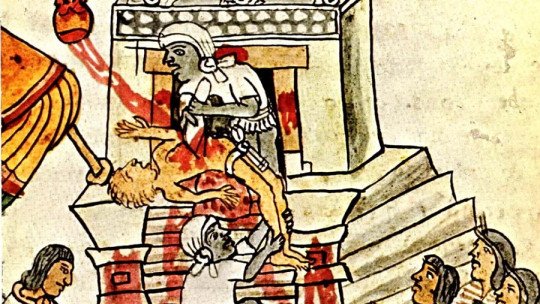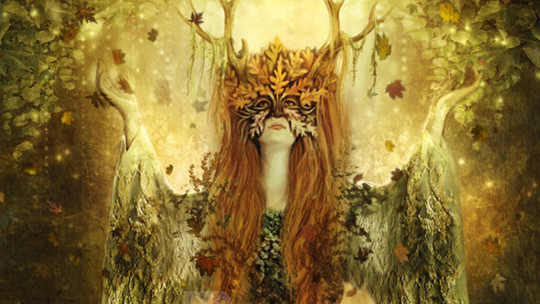
Ritual sacrifice has been a fairly widespread practice throughout the globe. In fact, anthropologists consider that all archaic religions have carried out some sacrifice, which does not have to be, of course, human, but is often limited to certain animals imbued with special characteristics or consecrated to certain gods. This is the case, for example, of the dove, an animal dedicated to the goddess Aphrodite in Greece and Venus in the Roman world.
The question is: What are the origins of ritual sacrifice? What drove the first human societies to kill, whether men, women or animals, in a religious act? If you are interested in the topic, keep reading. In today’s article we try to answer the question of why sacrifices were practiced in some religions.
The origins of ritual sacrifice
In all human acts, in general, a series of factors converge that result in the act itself. These factors can be religious in nature, but also social, cultural or simply related to survival. In the case of ritual sacrifice, and according to the research of anthropologists and historians, we also find different causes. A priori, we might think that it is only possible to explain these practices (which, to us, human beings of the 21st century, are completely foreign to us) through religion, but the fact is that there are other factors in the process. Let’s see it below.
1. Religious causes
The important role of religion in the development of the practice of sacrifice is undeniable. Although we find a great diversity of modus operandi, the common denominator of all of them is to establish a connection with the gods (either to appease their anger, or to ask them for favors) or to guarantee, through ritual bloodshed, the survival of the tribe.
Blood as a giver of life
Let’s pause for a moment on blood and its symbolism. Today we know how important this substance is for the maintenance of the body, as it guarantees the transport of nutrients and oxygen. Our ancestors, although they did not know all the details, knew perfectly well that blood was an essential element for life and that, when it left the body, the subject died.
In this sense, a parallel was established between blood and the continuity of the tribe. The fact follows a fairly common idea in all cultures, whereby “if I offer something on a small scale, this will be multiplied on a universal scale.” This is a kind of “sympathetic magic”, by which the blood shed in the sacrifice guarantees the continuation of blood (that is, life) in all beings.
Sacrifice as an offering to the gods
Blood, as a guarantor of life, connected directly with the gods; It was his food and his rebirth. Through blood the gods were strengthened, and, if they continued to live, so would the humans they created.
In this sense, we must keep in mind that there are many mythologies that insist on a primal and total “sacrifice”; the one who realizes divinity to create the world. In some of these myths, it is a literal dismemberment, as narrated in the Scandinavian creation myth: after defeating the fearsome giant Ýmir, Odin and the other gods tore him to pieces and molded the universe with his flesh (which gave rise to the earth), their hair and, of course, with their blood (with which they formed the sea and the rivers).
From this primordial sacrifice, the various cultures understood that human beings, the main creature of divine creation, They owed everything to the gods, who had created them “with pain.”. Thus, ritual sacrifice became a way of returning to divinity the enormous favor of life.
Sacrifice as divine food
There is still another religious reason, which is that of the “food of the gods”. In most ancient religions, the gods, although immortal and omnipotent, were very similar to human beings. Among their basic needs was food, which had to be scrupulously cared for, otherwise divine fury could be unleashed.
In ancient Greece, for example, there were two types of ritual sacrifice: on the one hand, the moirocaust, by which the offerer (who could be an individual or an entire city) offered the sacrifice to the gods as divine food ( in the form of combustion), but he reserved a part of the animal’s meat for his own consumption. This was, in fact, the most common ritual sacrifice. On the other hand, we find the holocaust, which consisted of offering the entire animal to the gods (also through the combustion of the meat with fire).
In both cases, It was understood that the divinity consumed the animal through smoke. And, also in both cases, the ritual sacrifice was not possible without a previous phase, the consecration, through which the priest or the paterfamilias (in the case of a private sacrifice) followed some essential steps to religiously prepare the animal and the assistants.
Sacrifice as gratitude
Finally, we also find religious sacrifice as a method of thanking the gods for some beneficial event for the person, the family or the community. For example, in Rome it was quite common to offer sacrifices to the lares, the spirits that protected the house, in gratitude for a favorable circumstance: a profitable marriage, the birth of a child, the cure of an illness…
2. Social causes
In addition to religious reasons, and although, a priori, we do not detect them, there are also social reasons for performing ritual sacrifices. According to a study carried out in 2016 by some anthropologists at the University of Auckland and Victoria University of Wellington, both in New Zealand, sacrifices would have facilitated the transition from early egalitarian communities to growing hierarchical societies.
To draw their conclusions, the researchers relied on the detailed study of various cultures. Scientists found evidence of the practice of sacrificial rituals in 43% of these societies, of which a high percentage belonged to highly hierarchical communities.
That is to say, there is evidence of a strong connection between ritual sacrifices and social hierarchy. What is this connection based on? It may have a lot to do with the power of the elites and their dominance over the less favored classes. Sacrifice would, in this sense, be a favorable vehicle for instilling fear and respect in the latter.
die for the king
We must also remember that in many ancient cultures rulers were considered divine beings, which made sacrifice, once again, something sacred. The Egyptologist Nacho Ares tells us in his article Human sacrifices in Egypt and Mesopotamia that, prior to the dynastic period, In the land of the Nile, human sacrifices were quite common ; in general, of the slaves and servants who had served a lord.
At Abydos, for example, in the tomb of Pharaoh Horus Aha (c. 3100 BC), 36 adjoining tombs were found in which the pharaoh’s sacrificed servants had been buried, intended to serve him in the afterlife. Over time, this practice was replaced by the ritual of burying the ushabtis, small statuettes that represented the service, with the monarch’s mummy.
Beyond the religious meaning of these sacrifices, there is a social reason, which is none other than to ensure the power of the ruler above that of his subjects. It is clear how ritual sacrifice increased (and maintained) hierarchies in primitive societies.
3. Causes related to punishment
Finally, we cannot ignore another possible origin of ritual sacrifice: the punishment of deviations and/or the violation of certain taboos. That is, when the individual did not behave as the community expected of him, sacrifice could be the penalty for this deviation from communal morality.
In short, sacrifice, both human and animal, has always been present in cultures around the world, whether for religious, social or punitive reasons, and, more commonly, as a hodgepodge of all of these. It is difficult for us to understand this type of practices, since we live in a society very far from these concepts, but we can make an effort to understand how and why ritual sacrifice arose.








